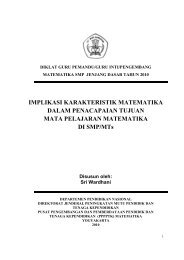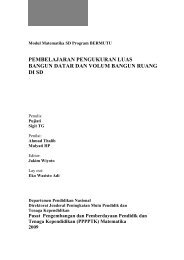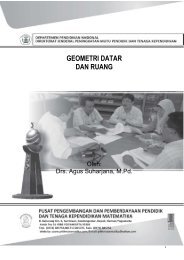25 Biggest Mistakes Teachers Make and How to Avoid Them
25 Biggest Mistakes Teachers Make and How to Avoid Them
25 Biggest Mistakes Teachers Make and How to Avoid Them
You also want an ePaper? Increase the reach of your titles
YUMPU automatically turns print PDFs into web optimized ePapers that Google loves.
Mistake 14: Inappropriate Educational Strategies<br />
SCENARIO 14.21<br />
Talk , Talk , Talk<br />
My worst experience with a teacher was in eighth grade at St. L.’s School. Her name<br />
was Mrs. D. Even as an eighth-grade student I realized that she was a bad teacher, the<br />
worksheet queen, Ms. Boring!! She taught her class in the lecture style all year long <strong>and</strong><br />
half the time I had no idea what she was talking about. She never smiled <strong>and</strong> never tried<br />
<strong>to</strong> make any connections with her students.<br />
Lecture can be an appropriate<br />
teaching strategy, but this<br />
strategy should be reserved for students<br />
at the high school level <strong>and</strong><br />
above. The younger the students, the<br />
more disengaged they become as<br />
time goes on. If lecture is used, it<br />
should be interesting <strong>and</strong> include as<br />
much media as possible. Integrating<br />
video, audio tapes, visual aids,<br />
PowerPoint-type computer presentations,<br />
<strong>and</strong> other sensory sources will<br />
keep students engaged <strong>and</strong> will<br />
enhance the effectiveness of lecture<br />
as a teaching strategy. Kindsvatter,<br />
Wilen, <strong>and</strong> Ishler (1988) suggest<br />
three ways <strong>to</strong> enhance the lecture<br />
presentation: Use visual aids, present<br />
simple material before complex<br />
material, <strong>and</strong> use nonverbal behaviors<br />
<strong>to</strong> hold students’ attention. This<br />
119<br />
teacher missed the mark on all three<br />
points. She used worksheets, a lessdesirable<br />
instructional <strong>to</strong>ol, she used<br />
no visual aids, <strong>and</strong> she presented<br />
complex material most of the time.<br />
She never smiled. This simple nonverbal<br />
expression would have helped<br />
her <strong>to</strong> connect with her students <strong>and</strong><br />
<strong>to</strong> minimize the gap that seemed <strong>to</strong><br />
emerge from her ineffective use of<br />
the lecture method.<br />
A more effective approach is articulated<br />
in the concept of connected<br />
teaching, proposed by Belenky, Clinchy,<br />
Goldberger, <strong>and</strong> Tarule (1986). They<br />
suggest that connected teachers<br />
function as a midwife who helps students<br />
give birth <strong>to</strong> their own ideas as<br />
opposed <strong>to</strong> functioning like a banker<br />
who merely makes knowledge deposits<br />
in a student’s head.<br />
SCENARIO 14.22<br />
Here an “F,” There an “F,” Everywhere an “F,” “F”<br />
My single worst experience in school was my high school economics teacher. I had this<br />
teacher my last semester during my senior year. On the first day I had his class, he<br />
s<strong>to</strong>od in the middle of the classroom <strong>and</strong> proceeded <strong>to</strong> tell us how he prided himself<br />
on failing students. From that moment on, I knew I was in trouble. He gave us two<br />
chapters <strong>to</strong> read every night <strong>and</strong> would lecture over things not in the book. His tests<br />
were hard because nobody ever knew what he would test us over. I had a horrible time<br />
making him happy with my projects. In the end, after working very hard, I made a B in<br />
the class.





